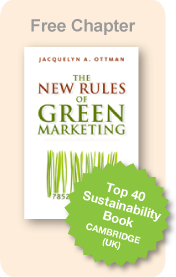Jacquie Ottman's
Green Marketing Blog
Why Jacquie Ottman’s Green Marketing Remains Relevant
September 08, 2009 by Jacquelyn Ottman
Guest post by Peter Korchnak, who writes the Sustainable Marketing Blog.
I recently read for the first time and reviewed Jacquie Ottman's Green Marketing: Opportunity for Innovation (2nd edition) and this is what struck me: "[M]ost of what I read nowadays about sustainability and marketing, Jacquie covered in Green Marketing more than a decade ago."
Though sustainability* has made inroads throughout the corporate world, with the likes of Nike and Walmart implementing sustainable practices on a large scale, green marketing literature and blogs recycle the same old themes. If green - or at least parts of it congruent with the established mass-consumption business models - has entered the mainstream, why does green marketing tread water?
I believe the story has two sides: both consumers and companies are responsible for the failure of green marketing to become the dominant business paradigm.
On the consumer side, I've identified a number of barriers to mass adoption of sustainability, most of which have to do with psychology. The human tendency to resist change and fall back to the familiar and the concrete render sustainability irrelevant to the average consumer's life. Green has a marketing problem in that it fails to tell a good story.
From that standpoint, part of green's failure is positioning. Green tends to be couched in ethical terms. The problem is, "sweatshop free", "not tested on animals", or "ecological" and other terms green marketing (ab)uses to advocate for green wares are too narrow in their appeal. Consumers who wish to consume altruistically represent narrow niches with limited growth potential. It's not that the average consumer doesn't care about the environment or community. Green comprises only a tiny sliver of the average consumer's purchases because green is just one of several factors in her purchasing decisions.
Paradoxically, green can only prevail in gaining mass acceptance if it diverts attention from itself. The average consumer must decide to buy your green product not because it's branded as green but because it satisfies her needs, whatever those may be. For example, American Apparel, a brand that is famous for its worker friendly labor practices, logo-less designs, and the Made-in-the-USA label, exploded into the mainstream only when it stopped touting its ethics and started selling "sexy T-shirts for young people". In other words, keep the product green, just don't try to sell it as such.
Green Marketing remains as relevant in 2009 as it was in 1998. For green marketing to succeed it must transition from the strategy of niche appeal to satisfying larger, more fundamental needs.
* Despite differences between the concepts, for the purposes of this post I use green and sustainable as interchangeable terms.
Jacquie Ottman's Green Marketing Blog welcomes guest posts. Please contact us if you would like to contribute.
Jacquelyn Ottman is president of J. Ottman Consulting, Inc., a New York-based marketing consulting firm that specializes in helping businesses derive competitive advantage from eco-innovation and green marketing. She is the author of Green Marketing: Opportunity for Innovation, 2nd edition.
Follow Jacquie on Twitter or read her Green Marketing Blog



 ShareThis
ShareThis

